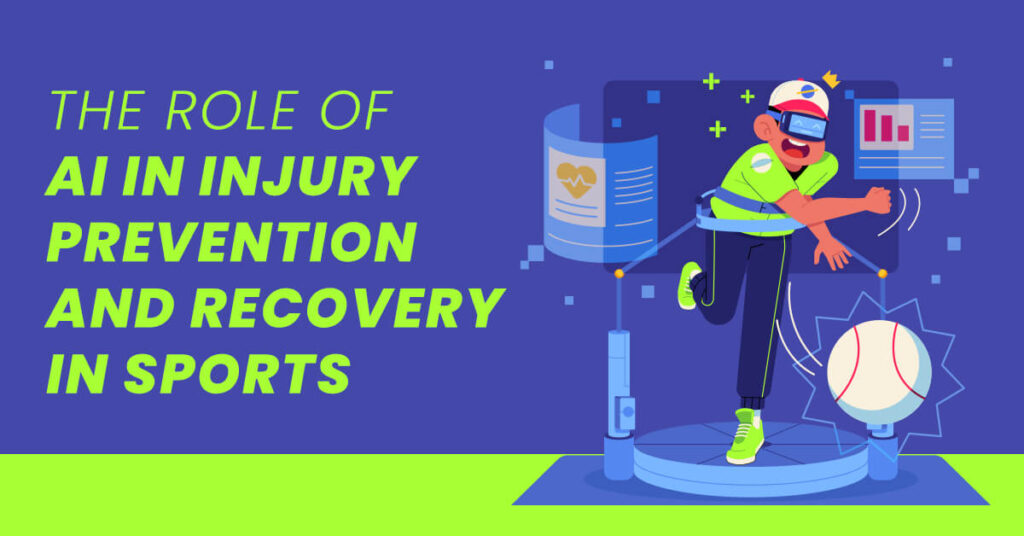Injury prevention and rehabilitation have always been critical aspects of sports medicine. For athletes, avoiding injury is as important as enhancing performance. With the emergence of AI, sports teams and medical professionals now have access to tools that can monitor an athlete’s physical condition in real-time, predict injury risks, and create tailored recovery programs. These developments are particularly important for elite athletes, whose careers depend on staying healthy and recovering quickly from injuries. In this context, AI in sports is proving to be a game-changer, offering data-driven insights that were previously unimaginable.
This article explores the various applications of AI in injury prevention and recovery, highlighting its growing importance in sports medicine.
How AI is Shaping the Future of Injury Prevention and Recovery in Sports
AI in Injury Prevention
Injury prevention has always been a challenge for athletes and their trainers. Despite advances in training techniques and equipment, injuries are still a common occurrence, often resulting in missed games and prolonged recovery periods. AI has stepped in to bridge this gap by offering real-time data and predictive analytics that help prevent injuries before they occur.
Biomechanical Data Analysis
One of the most significant contributions of AI in injury prevention is its ability to analyze an athlete’s biomechanics. Using wearable devices equipped with sensors, AI can monitor an athlete’s movements and identify potential risk factors. These devices collect real-time physiological data such as heart rate, body temperature, and muscle strain, which is then analyzed by AI algorithms to detect abnormal patterns.
For example, AI systems can track an athlete’s running gait and determine whether they are overloading certain muscle groups or joints, which could lead to an injury. If the AI detects any irregularities in movement, coaches and medical professionals can make immediate adjustments to the athlete’s training regimen to avoid injury. This is particularly useful in sports where repetitive strain injuries are common, such as long-distance running, basketball, or soccer.
Predictive Analytics for Injury Risks
Beyond real-time monitoring, AI also excels in predictive analytics, which allows it to forecast the likelihood of an injury occurring. By analyzing historical data and training loads, AI can identify patterns that may increase the risk of injury. Machine learning models are particularly effective in this area, as they can assess vast datasets, including previous injuries, biomechanics, and workload, to predict when an athlete is at risk.
For example, a soccer player who consistently plays full 90-minute matches without sufficient rest is at a higher risk of sustaining a muscle injury. AI can flag this risk based on data collected from previous matches, training sessions, and the player’s physical condition. Coaches and medical teams can then use this information to adjust the player’s training or playing schedule to mitigate the risk of injury.
The application of AI in this area is not limited to professional athletes. Amateur athletes can also benefit from AI-driven injury prevention technologies, as these systems are becoming more accessible and cost-effective.
AI in Recovery and Rehabilitation
Once an injury occurs, the focus shifts to recovery, and AI continues to play a pivotal role in this phase. Traditional recovery programs often follow a one-size-fits-all approach, which can be inefficient and slow. AI changes the game by providing personalized rehabilitation plans that are tailored to an athlete’s specific injury, recovery progress, and overall health status.
Personalized Rehabilitation Plans
AI’s ability to provide personalized recovery plans is one of its most powerful features. Using data from wearable devices and medical assessments, AI can create a rehabilitation program that adapts to the individual needs of the athlete. These programs can include exercises tailored to the type and severity of the injury, as well as recommendations for rest and nutrition.
For instance, an AI-driven platform can track an athlete’s recovery progress in real-time and make adjustments to their rehabilitation plan as needed. If an athlete is recovering from a hamstring injury, the AI system might recommend lighter exercises during the initial stages of recovery, gradually increasing the intensity as the athlete regains strength. This level of personalization ensures that the athlete is not pushed too hard, reducing the risk of re-injury.
Moreover, AI can provide real-time feedback during the rehabilitation process. By analyzing data from wearables, such as heart rate monitors and motion sensors, AI can assess whether an athlete is performing exercises correctly and safely. This instant feedback allows trainers to make adjustments on the fly, ensuring that the rehabilitation process is both effective and efficient.
Real-Time Monitoring and Adjustments
AI doesn’t just provide static recovery plans; it continuously monitors an athlete’s recovery process and suggests adjustments when necessary. This is particularly valuable in the case of long-term injuries, where the athlete’s condition may change over time.
For example, if an AI system detects that an athlete’s range of motion is improving faster than expected, it may recommend increasing the intensity of their exercises to accelerate recovery. Conversely, if progress is slower than anticipated, the AI can adjust the program to prevent overexertion. This level of adaptability ensures that the athlete’s recovery is optimized at every stage, reducing downtime and minimizing the risk of complications.
Also read:
The Future of Artificial Intelligence: Transforming Industries
Future of AI in Sports Injury Management
As AI technology continues to evolve, its applications in sports injury management will only become more sophisticated. Future developments in AI are likely to focus on even more accurate predictive models, advanced virtual reality (VR) tools for rehabilitation, and greater integration with wearable technology.
Advancements in Predictive Models
AI’s predictive capabilities are already impressive, but ongoing research is expected to make these models even more accurate. In the future, AI will likely be able to predict injuries with greater precision by incorporating more variables into its calculations, such as genetic data and psychological factors.
This could lead to a new era of injury prevention, where AI not only predicts when an injury is likely to occur but also identifies the root causes of the injury. By addressing these underlying issues, medical teams can prevent injuries before they even have a chance to develop.
Virtual Reality in Rehabilitation
Another exciting development is the use of virtual reality (VR) in rehabilitation. AI-driven VR tools are already being used to help athletes recover from injuries by immersing them in virtual training environments. These environments allow athletes to practice movements and exercises in a controlled setting, helping them regain confidence and strength without the risk of re-injury.
As VR technology continues to improve, it is likely to become a standard part of the rehabilitation process for athletes, offering new ways to accelerate recovery and enhance performance.
Conclusion
AI is revolutionizing the way athletes prevent and recover from injuries. From real-time biomechanical analysis and predictive analytics to personalized rehabilitation programs and continuous monitoring, AI provides a level of precision and adaptability that was previously unattainable. As AI in sports medicine continues to advance, athletes can expect faster recovery times, reduced injury risks, and longer, healthier careers.
By leveraging the power of AI in sports, athletes and medical professionals can work together to ensure that every aspect of training, performance, and recovery is optimized for success. The future of sports medicine is bright, and AI will undoubtedly be at the forefront of this exciting transformation.



